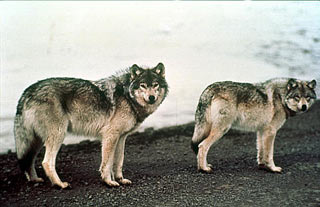Alaskan wolves began extinction 12,000 years ago
Danh Phuong
The ancient gray wolves of Alaska began to become extinct about 12,000 years ago, while today's Alaska wolves are not descendants of their descendants, but of other sub-species, an international group of scientists reported. July 3 report in the publication published in Current Biology.
Scientists analyzed DNA samples, examined the 14th carbon dating and studied the chemical composition of ancient wolves at the National Institute for Natural History at the Smithsonian. They then compared the results with today's wolves and found that the two results are genetically different.
Blaire Van Valkenburgh , professor of the Department of Ecology and Evolutionary Biology at the University of California (UCLA) - Los Angeles, who won the Excellent Teaching Award from UCLA University, co-author of the study said: ' Gray wolves of ancient times in Alaska were all more alike than any wolves in Eurasia and South America today. '
 (Photo: Picturethis.pnl.gov) The study is funded by the National Science Foundation, funded by the federal government.
(Photo: Picturethis.pnl.gov) The study is funded by the National Science Foundation, funded by the federal government.
"Ancient gray wolves lived continuously in Alaska from at least 45,000 years ago - or pretend to be earlier, but carbon 14 dating does not allow for earlier establishment - until about 12,000 years ago , " said Van Valkenburgh.
The size of ancient gray wolves is not much different from that of present-day Alaskan wolves, although the fangs and healthy jaw muscles are somewhat larger. They can kill huge bison.
" The old wolves used to suffer many broken teeth and teeth , " she said.
She also studied pieces of broken teeth in ancient animals in Los Angeles' Rancho La Brea Tar Pits and in ancient lions, leopards, puma and wolves. The ancient large mammals often broke their teeth when they ate, chewing on prey bones more often than today's identical mammals. Why so?
'Because they are hungry, this kind of thing is probably because it is very difficult to catch and retain prey when there is a lot of competition and looting of predators, forcing them to eat very quickly. Perhaps because they are living in overcrowded populations that even we can hardly imagine, along with encounters between carnivores together, ' Van Valkenburgh said.
The toothed cat and other large mammals have become extinct about 10,000 to 11,000 years ago when their prey did not appear again due to many factors, including your hunting. people and warmth gradually bring about the drama of the Earth at the end of the Pleitocene.
Before this new study began, it was not known whether Alaska gray wolves and in other areas originated from the ancient gray wolf that was found in the Pleitocene or extinct. or near extinction has been present in gray wolves from northern North America.
What does the study imply about the global warming today?
'When environmental changes take place too quickly, animals cannot adapt quickly, especially when there are too few places for them to move as a place to cram to live; that is, when they tend to go to ruin, at the end of the Pleitocene, climate changes very quickly. Van Valkenburgh said
- Humans and dogs evolved together
- Little known facts about wolves
- Launched a fight against wolves in Russia
- The truth behind the photo of a humorous wolf population is causing storms to the online community
- Detecting a sudden 'water monster' in the Fukushima Sea
- The 'werewolf' 100% real version: Extraordinary, aggressive, attacks both polar bears
- Video: The war between wolves and buffaloes
- Producing electricity from beer residues
- Forget the dinosaurs, this is the most horrifying extinction in Earth's history
- Europe at risk of radiation radiation
- 'Ice tsunami' buried 52 American bulls
- Reptiles stand upright after the Fermi extinction
 Animal 'suffering' after hibernation
Animal 'suffering' after hibernation Why do goats climb well?
Why do goats climb well? Scientists were surprised to see chimpanzees eating turtles
Scientists were surprised to see chimpanzees eating turtles Giant catfish died deadly due to drought in Thailand
Giant catfish died deadly due to drought in Thailand